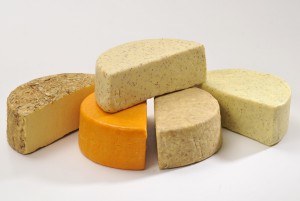21st March 2014 Warsaw, Poland
Say Cheese – Say Yarg
Say Cheese – We’ve been all the way to Cornwall to taste some YARG
Piesek P is on the lookout for GREAT British Cheese in Poland – as he finds it he’ll let you know – just smile!
Produced from a recipe which dates back to the 13th century, Cornish Yarg cheese was conceived and first produced in its present form by a cheese-making couple, Allan and Jenny Gray, on their farm near Bodmin Moor. Its unusual name stems not from the Cornish language but is simply their surname spelt backwards.
Its semi-hard texture is often compared to that of Caerphilly at its core, though the outer layer is distinctly creamier, and its identifying feature is the edible jacket of nettle leaves it wears. Unique to Cornish Yarg, and originally intended to aid preserving and as a mould ripening method, the nettles also lend this cow’s milk cheese a distinctive flavour. The leaves are picked locally and frozen to remove the sting, then brushed on by hand. Though internationally popular, Yarg is still hand-made and produced using vegetarian rennet and milk from its own herd.
Cornish Yarg is a unique cheese for although it follows a Wensleydale style recipe it differs in a number of ways. It is a smaller size than a traditional Wensleydale, the nettle leaves wrapped around it after it has come out of the cheese press and a light spraying of “penicillium candidum” white mould to help give the cheese its unique appearance and flavour. Both the leaves and the white mould add an interesting dimension to the cheese. Yarg is defined as a semi-hard cheese is deliciously creamy under the rind and slightly crumbly in the core. It has a young, fresh, slightly tangy taste.

Going a step further on the flavour, Cornish based Lynher Dairies, who now produce the cheese having purchased the recipe from the Grays in the 1960s, have also developed a Yarg enveloped in the leaves of the wild garlic plant known, logically, as Cornish Wild Garlic Yarg.
Milk is collected from Lynher’s own herd of Ayrshire, Jersey and Friesian cross cows, and from other carefully selected local farms who share our commitment to happy animals and healthy pastures. The curd is pressed and brined before being wrapped in wild nettle leaves that are taken from the Cornish countryside between May and September. Many people also know that they can be delicious – and sting-free – when cooked. But they have lots of other surprising qualities. For hundreds of years they’ve been used to treat a whole range of ailments. They’re widely held to have antiseptic and anti-inflammatory qualities, and even to stimulate hair growth! Nettles can help arthritis perhaps explaining why the Romans used flogging with nettles as a cure for rheumatism.
Nettles are rich in minerals and in vitamins A and C. Nettle products include soup, tea, nettle pudding, porridge and beer – and of course Yarg cheese, to which they give a subtle, mushroomy flavour. A young yarg has a fresh and lemony flavour with a touch of herbs. Older cheeses become creamier, more aromatic and slightly peppery and develop scatterings of brown and grey moulds across the rind.
Cornish Yarg has been made near Truro in west Cornwall for over 25 years. Cornish Yarg has won Gold at both the British and World Cheese Awards. Lovely with crackers and fine wine. Try crumbling it on the top of salads. A Great addition bathed in mushroom soup.
Say Cheese – Say Yarg – The King of Cornish Cheeses – Taste some for yourself today